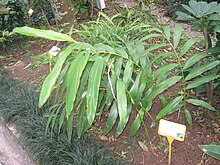| Wurfbainia villosa | |
|---|---|

| |
| W villosa at the Hong Kong Botanical Garden | |
|
Scientific classification
| |
| Kingdom: | Plantae |
| Clade: | Tracheophytes |
| Clade: | Angiosperms |
| Clade: | Monocots |
| Clade: | Commelinids |
| Order: | Zingiberales |
| Family: | Zingiberaceae |
| Genus: | Wurfbainia |
| Species: | W. villosa
|
| Binomial name | |
| Wurfbainia villosa (Lour.) Skornick. & A.D.Poulsen
| |
| Synonyms | |
| |
Wurfbainia villosa, also known by its basionym Amomum villosum, [2] ( Chinese: 砂仁; pinyin: shārén) is a plant in the ginger family which is grown as a cardamom-like spice throughout Southeast Asia and South China. [3] Like cardamom, the plant is cultivated for its fruits, dry capsules containing strongly aromatic seeds. [4] W. villosa is an evergreen monocotyledonous plant 1.5 to 3.0 m in height, the branches and leaves of which are similar to those of ginger. It grows in the shade of trees and has a reproductive peculiarity whereby those flowers borne on creeping growth at ground level will set fruit, while those borne on aerial branches will not. It blooms in March and April, the colour, translucency and waxy lustre of the flowers being likened traditionally to those of white jade.
The seed of Wurfbainia villosa is used as a spice in Chinese cuisine, in which it can also form an ingredient in certain recipes for the traditional spice mixture known as five-spice powder. [5] [4] From as early as the time of the Tang dynasty, many ancient books, including, notably, the Compendium of Materia Medica, have been unanimous in describing the taste of W. villosa as “acrid, fresh, and slightly bitter”.
Due to the demand for seeds and ripe fruits, and to curb slash-and-burn activities in forests by local populations, cultivation of W. villosa and coplantings with rubber trees has been encouraged by the governments of Yunnan and Guangdong, China. [6] However, the extensive cultivation of W. villosa in forests has resulted in the reduction of species diversity in the rainforests of Southwest China. [7]
- ^ Leong-Skornickova, J.; Tran, H.D.; Newman, M.; Lamxay, V.; Bouamanivong, S. (2019). "Wurfbainia villosa". IUCN Red List of Threatened Species. 2019: e.T202235A132696966. doi: 10.2305/IUCN.UK.2019-3.RLTS.T202235A132696966.en. Retrieved 18 November 2021.
- ^ POWO: Wurfbainia villosa (Lour.) Skornick. & A.D.Poulsen (retrieved 15 July 2020)
- ^ "Amomum villosum", Encyclopedia of Life
- ^ a b G. Li; A.J. Chen; X.Y. Chen; X.L. Li & W.W. Gao (2010), "First report of Amomum villosum (cardamom) leaf lesion caused by Pyricularia costina in China", New Disease Reports, 22 (2): 2, doi: 10.5197/j.2044-0588.2010.022.002
- ^ "Back to basics - Homemade five spice powder". Sunflower Food Galore. 11 February 2011. Retrieved 23 February 2021.
- ^ Zhou, Shouqing (1993), "Cultivation of Amomum villosum in tropical forests", Forest Ecology and Management, 60 (1–2): 157–162, doi: 10.1016/0378-1127(93)90029-M
- ^ Liu, Hongmao; Gao, Lei; Zheng, Zheng; Feng, Zhili (2006), "The impact of Amomum villosum cultivation on seasonal rainforest in Xishuangbanna, Southwest China", Biodiversity and Conservation, 15 (9): 2971–2985, doi: 10.1007/s10531-005-3876-4, S2CID 10958050
-
 Media related to
Amomum villosum at Wikimedia Commons
Media related to
Amomum villosum at Wikimedia Commons
